Have you ever wondered what does 50 pounds of luggage look like? Whether you’re a seasoned traveler or preparing for your first journey, understanding the visual representation of this weight limit is essential. Picture a suitcase filled to the brim, with items carefully packed, zippers straining to contain the contents within. In this brief overview, we’ll try to explore the dimensions, contents, and challenges associated with what does 50 pounds of clothes look like, offering insight into the world of efficient packing and travel preparation.
How Much Does a Suitcase Weigh?
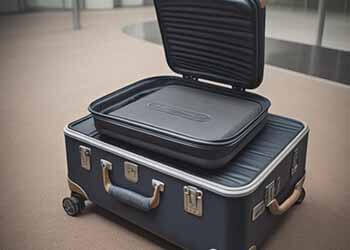
The weight of a suitcase can vary widely depending on several factors:
1. Type of Suitcase:
The type of suitcase you have greatly influences its weight. Different types include carry-on luggage, checked luggage, and specialty luggage like hard-shell or soft-shell suitcases. Each type can have different base weights.
2. Size of the Suitcase:
Larger suitcases tend to weigh more than smaller ones, even if they are empty. This is because larger suitcases have more material, zippers, and hardware, which contribute to their weight.
3. Material:
The material used to make the suitcase also affects its weight. For example, hard-shell suitcases made of polycarbonate or ABS plastic are typically heavier than soft-shell suitcases made of lightweight nylon or polyester.
4. Brand and Model:
Different brands and models of suitcases have varying weights, even if they are of similar size and type. Some brands prioritize lightweight materials and design, resulting in lighter suitcases.
5. Features:
Suitcases with extra features like built-in TSA locks, expandable compartments, or integrated charging ports may be heavier due to the added components.
6. Wheels and Handles:
The type and quality of wheels and handles can impact a suitcase’s weight. Spinner wheels and telescopic handles add weight but provide convenience and maneuverability.
Generally, an empty carry-on suitcase can weigh anywhere from 5 to 10 pounds (2.3 to 4.5 kilograms), while an empty checked suitcase can range from 8 to 15 pounds (3.6 to 6.8 kilograms) or more, depending on its size, material, and features. Keep in mind that airlines have specific weight limits for both carry-on and checked luggage, so it’s crucial to check their policies to ensure your suitcase, along with its contents, doesn’t exceed these limits.
Related: Best Lightweight Luggage For Seniors
Is A 50 Pounds of Luggage Very Big?
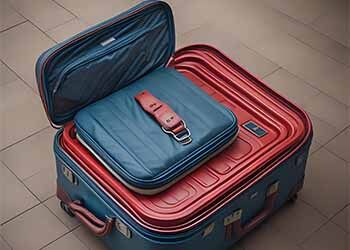
The size of 50 pounds of luggage can vary depending on the type of luggage you’re using and how efficiently you pack. In terms of weight, 50 pounds is a standard limit for checked baggage on many airlines. The physical dimensions of the luggage, however, can vary greatly.
A 50-pound suitcase could be a large and bulky piece of luggage, especially if it’s filled with clothing, shoes, and other items. On the other hand, if you’re packing dense or compact items like books or electronics, the size may be smaller. It’s essential to consider both the weight and size restrictions imposed by your airline to ensure your luggage complies with their policies.
What Does 50 Pounds Of Luggage Look Like?
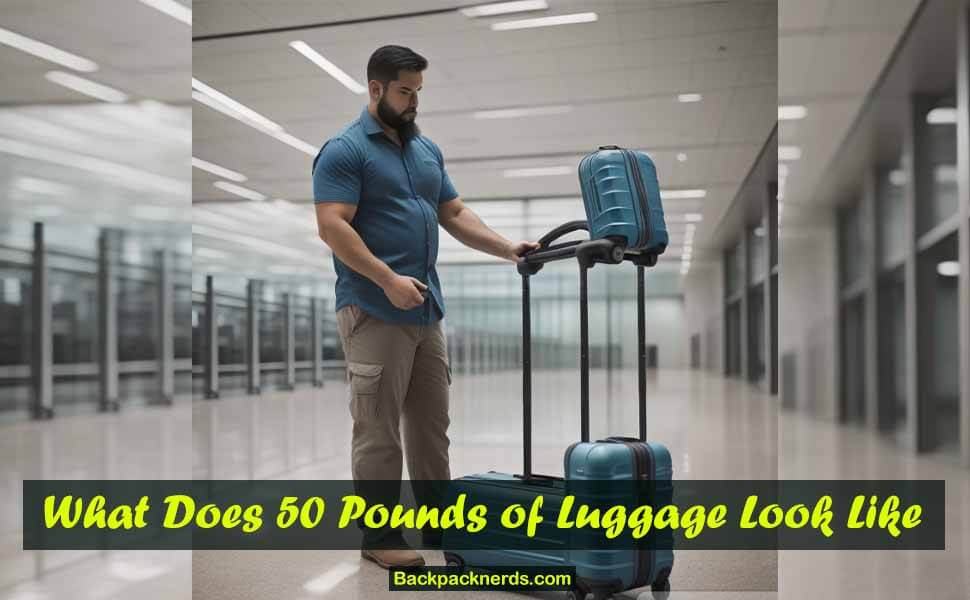
So, how much is 50lbs of luggage, really? How big is a 50 pound luggage?
Well, if you have never been accompanied with a 50 lbs of luggage then it is very simple to raise a question in your mind- what does 50 pounds of luggage would be? Some people ask- what does 40 lbs of luggage look like?
Well, the answers vary depending on the size, stuff you are taking, design, and so on. So, without thinking too much about how to keep luggage under 50 pounds, let’s acquire some knowledge of it and try to understand it.
The Visual Impact
First off, we need to discuss the visual impact of what 50 pounds of luggage looks like.
When we think about 50 pounds of luggage, the first thing that comes to mind is the visual impact it creates. Picture this: a suitcase that’s bursting at the seams, straining under the weight of its contents. It’s not just about the number 50; it’s about the heft, the bulk, and the challenge it presents to travelers.
To truly grasp the concept, imagine trying to carry it. You’d likely struggle as you heave it off the luggage carousel or lug it up a flight of stairs. It’s a weight that commands attention, both in terms of its size and the effort required to handle it.
Now, let’s break it down further. The weight-to-size ratio is crucial here. Even though 50 pounds may not sound like a lot in daily life, when packed into a suitcase, it can fill the space quite differently. That’s why understanding what 50 pounds of luggage looks like becomes essential for travelers looking to avoid over-packing or hefty baggage fees.
Here, I have ONE question:
How much space does 50 pounds occupy?
To understand what 50 pounds of luggage looks like, consider that it’s not just about weight; it’s also about volume. The space it occupies depends on what you pack. For instance, if you fill your suitcase with clothing, it can take up a significant amount of space due to the fluffiness and varied sizes of clothes. On the other hand, if you’re packing dense items like books or electronics, 50 pounds may occupy less physical space. The contents and how you arrange them within the luggage matter as much as the weight itself.
However, it will help you understand more how big a 50 pound luggage is if you visualize it. So, let’s visualize a typical suitcase.
Visualize a typical suitcase:
Well, think of a typical large suitcase used for international or extended trips. These suitcases typically measure around 28-30 inches in height, 18-20 inches in width, and 10-12 inches in depth. Now, imagine this suitcase packed to its weight limit of 50 pounds. It’s not just a matter of filling it to the brim; it’s about ensuring that the weight is distributed evenly to avoid exceeding airline restrictions or making it difficult to transport. This visualization helps travelers gauge the sheer bulk of 50 pounds of luggage within the confines of a standard suitcase.
What Can You Pack In 50 Pounds Of Luggage?

Do you have any idea – What size luggage can hold 50 lbs.? Or, how big is a 50-pound suitcase?
Okay, it is high time that we found out the contents of a 50 lb luggage bag, covering everything from clothing and toiletries to electronics and travel essentials.
Remember, efficient packing strategies and considerations for different types of items will help you make the most of your allotted weight limit while ensuring a smooth travel experience. So, whether you’re a frequent flyer or embarking on a new adventure, read on to discover how to pack smartly within your 50-pound baggage allowance.
Here are some examples of what you can pack in 50 pounds of luggage:
- Clothing: You can pack a wide variety of clothing items, including shirts, pants, dresses, jackets, and underwear. To maximize space, consider rolling your clothes or using packing cubes to keep items organized and minimize wrinkles.
- Shoes: Depending on the size and weight of your shoes, you can typically fit several pairs in 50 pounds of luggage. It’s a good idea to place shoes in plastic bags to prevent them from soiling your clothing.
- Toiletries: Toiletries like shampoo, conditioner, body wash, and other personal care items can easily fit in your luggage. Be sure to place them in leak-proof containers and consider travel-sized options to save space.
- Electronics: You can pack items like laptops, cameras, chargers, and other electronics, but be mindful of their weight and fragility. Use padded cases or sleeves to protect them during travel.
- Travel Accessories: Items like travel adapters, portable chargers, travel pillows, and eye masks are handy additions to your luggage for a comfortable journey.
- Documents: Don’t forget essential documents like passports, visas, travel itineraries, and identification. Keep these in a secure, easily accessible pocket or pouch.
- Medications: If you have prescription medications or over-the-counter remedies, ensure you pack an adequate supply along with any necessary prescriptions or documentation.
- Snacks and Water: Depending on your travel plans, you can include snacks and an empty reusable water bottle to stay hydrated and satiated during your journey. Remember to check airport regulations for carrying liquids.
- Books or Entertainment: If you enjoy reading or need entertainment during travel, bring a book, e-reader, or tablet loaded with movies, music, or games.
- Travel Gear: Items like travel umbrellas, locks for your luggage, and a lightweight backpack for day trips can also be packed efficiently.
Remember to prioritize essential items and consider the climate and duration of your trip when deciding what to pack. Be mindful of weight limits imposed by airlines and the specific requirements of your travel destination. Efficient packing can help you make the most of your 50 pounds of luggage while ensuring you have everything you need for a comfortable and enjoyable trip.
How to Pack Smartly Within Your 50-Pound Baggage?
Packing smartly within your 50-pound baggage allowance involves careful planning and organization. If you are going out for days, you must have a plan as to what you need to take and what you can avoid. Besides you need to know what size luggage can hold 50 lbs.
So, how do you pack a suitcase under 50 pounds? That means how can I pack a suitcase under 50 pounds?
I know this is a lot to process in your brain. But why don’t we try to figure it out simply?
Now, let’s learn what to prioritize more and what not to make my luggage under 50 pounds.
Here are some valuable and important tips.
- Create a Packing List: Start by making a comprehensive list of the items you need to bring. Prioritize essentials and consider the climate and activities at your destination.
- Choose Versatile Clothing: Opt for clothing items that can be mixed and matched to create multiple outfits. This reduces the number of clothes you need to pack.
- Pack Efficiently: Roll your clothes instead of folding them to save space and reduce wrinkles. Use packing cubes or compression bags to further maximize space and keep items organized.
- Limit Shoes: Shoes can be heavy and take up a lot of space. Try to bring only a few pairs that can work for various occasions.
- Minimize Toiletries: Use travel-sized toiletries or transfer products into smaller containers to save weight and space. Consider buying items like shampoo and toothpaste at your destination if possible.
- Check Airline Policies: Understand the baggage policies of your airline, including weight and size restrictions. Be prepared to pay fees for overweight luggage if you exceed the limit.
- Weigh Your Luggage: Use a luggage scale to weigh your bag before heading to the airport to ensure it doesn’t exceed the weight limit.
- Layer Clothing: Wear your heaviest and bulkiest clothing items (like a jacket or boots) during travel to free up space in your luggage.
- Use Travel Accessories: Invest in travel-friendly accessories like portable chargers, lightweight towels, and multi-purpose items to save space and weight.
- Consider Laundry Options: If your trip is longer, look for accommodation with laundry facilities or plan to do laundry during your journey to reduce the number of clothes you need to pack.
By following these packing tips, you can make the most of your 50-pound baggage allowance while ensuring you have everything you need for a comfortable and enjoyable trip.
That’s great that I packed my luggage with my necessary stuff. But the main question is how to tell if my luggage is over 50 pounds or not?
How Big Is A 50 Pound Luggage?

The size of a 50-pound luggage can vary significantly depending on the type of luggage you have and how densely you pack it. The weight of a suitcase primarily depends on its contents rather than its physical dimensions. However, I can provide you with some general guidelines:
Checked Luggage:
A 50-pound checked suitcase is typically a larger piece of luggage, often referred to as a “checked bag.” These can vary in size, but a common size for a 50-pound checked bag might have dimensions of around 27-32 inches in height, 18-20 inches in width, and 10-12 inches in depth. These are rough estimates, and the actual dimensions can vary by brand and model.
Carry-On Luggage:
If you’re referring to a 50-pound carry-on suitcase, that would be exceptionally heavy for a carry-on. Most airlines have much lower weight limits for carry-on luggage, typically around 15 to 22 pounds (7 to 10 kilograms). A carry-on suitcase’s dimensions are generally smaller to fit within the airline’s size restrictions, which vary but are commonly around 22 x 14 x 9 inches.
It’s crucial to note that the dimensions and weight limits for luggage can vary by airline and destination, so it’s essential to check with your specific airline for their policies and requirements. Additionally, how you pack your luggage, the material it’s made of, and the specific design will influence its size and capacity. Always check with your airline for their size and weight restrictions to ensure your luggage is compliant.
How Do I Know If My Bag Is 50 Lbs?
When bagging a suitcase, it is a common concern about what if my luggage is over 50 pounds? Or how do I understand whether my luggage is already exceeding 50 pounds or not?
Well, in this case, discovering the weight of your bag, especially when it approaches the 50-pound limit, is crucial for a smooth travel experience. Whether you use a dedicated luggage scale, a bathroom scale, or rely on the airport’s check-in services, understanding your bag’s weight ensures compliance with airline regulations and avoids unexpected fees. Read on to learn more about these methods and tips for hassle-free packing.
Well, to know if your bag weighs 50 pounds, you can use one of the following methods:
1. Use a Luggage Scale:
The most accurate way to determine the weight of your bag is by using a luggage scale. These portable devices are designed for precisely measuring the weight of your luggage. Simply attach the scale to the bag’s handle, lift it off the ground, and read the weight displayed on the scale.
2. Use a Bathroom Scale:
If you don’t have access to a luggage scale, you can use a regular bathroom scale to estimate your bag’s weight. First, weigh yourself without the bag and note the weight. Then, pick up your bag and stand on the scale again, this time holding the bag. The difference between the two weights will give you an approximate weight of your bag.
3. Airport Check-In:
When you arrive at the airport, you can use the airline’s check-in counter or kiosk to weigh your bag. Airlines have scales specifically for this purpose, and they will inform you if your bag exceeds the weight limit. Keep in mind that if your bag is overweight, you may incur additional fees.
4. Online Baggage Allowance Information:
Before heading to the airport, check your airline’s baggage allowance information on their website. Airlines typically specify the maximum weight allowed for checked luggage. Ensure your bag does not exceed this limit when packing.
It’s essential to check your bag’s weight before arriving at the airport to avoid any surprises, such as excess baggage fees or the need to remove items from your luggage. Packing efficiently and using a luggage scale or other weighing methods can help you stay within your airline’s weight limit.
How to Weigh Checked Luggage?
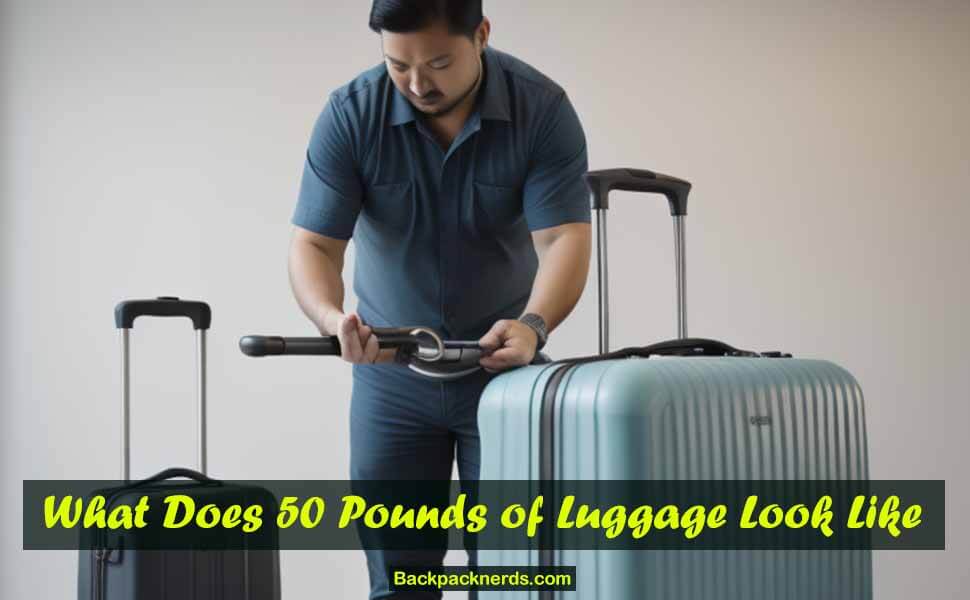
You can weigh your suitcase in several ways. However, most popular ways to weigh your luggage have been mentioned below:
Luggage Scale:
One common method to weigh your luggage is by using a dedicated luggage scale. These portable devices are easy to use and provide accurate readings. To weigh your luggage with a luggage scale, attach the scale’s hook or strap to the luggage handle or a sturdy part of your bag. Lift the luggage off the ground using the scale and read the weight displayed on the scale’s screen. This method is particularly handy for larger and heavier suitcases.
Bathroom Scale:
For smaller bags, such as carry-ons or backpacks, you can use a bathroom scale. Start by weighing yourself first without holding anything and take note of your weight. Then, step onto the scale again while holding your bag, making sure it’s off the ground. The difference between the two weights is the weight of your bag. This method is suitable for smaller bags that can be easily lifted.
Airport Baggage Scale:
Lastly, when you’re at the airport, most check-in counters have baggage scales available for travelers to use. Simply place your luggage on the scale, and it will provide you with the weight measurement. This is a convenient option if you want to double-check your luggage’s weight before checking it in for your flight.
These ways are very common and easy to weigh your luggage before checking in. If you don’t make sure your luggage is following the airline’s rules and regulations, you might have to face a hard time. This is exactly why, you have to double-check whether everything is okay or not.
How to Weigh Luggage without a Scale?

Do you know how to check luggage weight at home without scale? Ensuring the right weight according to the airline’s regulations of your checked luggage is truly important. If you ignore to follow their directions, you are going to have a rough day after all. And that’s exactly why, you should check your luggage weight with or without a scale at home.
In this case, if you don’t want to use the traditional and most common ways such as a luggage scale, or a bathroom scale, or rely on the airport’s check-in services, you should know how to weigh luggage without a scale.
It is highly recommendable to carry a travel luggage weight scale with you while you are traveling frequently.
However, weighing a suitcase without a scale can be done using these alternative methods:
1. Use a See-Saw Method:
If you have access to a see-saw or a large lever, you can create a makeshift balance. Place a known weight (like a heavy object or a bag filled with known weights) on one end and your suitcase on the other. Adjust the position of the known weight until the see-saw is level. The weight of your suitcase is roughly equal to the known weight on the other end.
2. Luggage Comparison:
If you have a smaller suitcase or bag with a known weight (such as a carry-on bag), you can compare it to your larger suitcase by holding one in each hand. By alternating between the two and gauging the difference, you can estimate the weight of your larger suitcase.
3. Use Your Body Weight:
Weigh yourself first without holding anything, and then weigh yourself again while holding the suitcase. The difference between the two weights is an estimate of the suitcase’s weight. Keep in mind this method may not be as accurate as using a scale.
4. Estimate by Feel:
If you’re experienced with lifting luggage, you might be able to estimate the weight by how it feels compared to objects you’re familiar with, such as bags of groceries or books. This method is less precise but can provide a rough estimate.
5. Compare to Known Weights:
If you have known weights, like dumbbells or bags of sugar, you can hold one in each hand and compare the weight with your luggage by alternating between holding the weights and your bag. This method provides an estimate of your bag’s weight.
6. Use an App:
Some smartphone apps claim to estimate weight based on the sound when tapping an object. While less accurate than scales, these apps can provide a rough estimate.
Remember that these methods are not as accurate as using a dedicated luggage scale, so it’s essential to leave some margin for error to ensure you don’t exceed your airline’s weight limit. If possible, consider borrowing a scale or visiting a location that offers luggage weighing services to get a more precise measurement. Read more.
What If My Luggage Is Over 50 Pounds? What to Do?
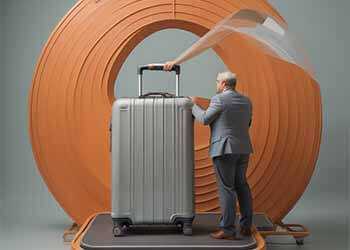
Checked luggage over 50 pounds can be great harassment for anyone if the airline has strict restrictions. This is how you can find yourself in a difficult situation. So, how do you pack a suitcase under 50 pounds? How to keep luggage under 50 pounds?
In this case, if your luggage is over 50 pounds, you’ll need to take some steps to address the situation:
- Repack: Open your suitcase and assess its contents. Consider removing non-essential items or finding lighter alternatives. Repack your bag with the goal of reducing its weight.
- Distribute Weight: If you’re traveling with a companion and their luggage is under the weight limit, consider redistributing some of your items into their bag to even out the weight.
- Remove Items: If reducing the weight by repacking isn’t enough, you may need to remove items from your luggage altogether. Focus on items that are less essential for your trip.
- Pay Excess Fees: If you can’t reduce the weight sufficiently, be prepared to pay excess baggage fees at the airport. Airlines have varying fee structures, so check with your airline in advance to understand the costs associated with overweight luggage. It’s typically less expensive to pay these fees online in advance rather than at the airport.
- Ship Items: In some cases, especially if you have items you must bring but can’t fit within your luggage weight limit, you might consider shipping them to your destination separately. This can sometimes be more cost-effective than paying hefty excess baggage fees.
- Upgrade to a Higher Allowance: If you’re a frequent traveler or if the additional fees for overweight luggage are substantial, consider upgrading your ticket to a higher fare class that offers a higher luggage weight allowance. This might be more cost-effective if you frequently travel with heavier luggage.
Remember to check your airline’s specific policies regarding excess baggage fees and weight limits, as they can vary between carriers. It’s essential to address the issue of overweight luggage before you arrive at the airport to avoid stress and potential delays during check-in. know more from Quora.
Frequently asked questions [50 lb Luggage Bag]
Q1: What is the typical weight limit for checked luggage on airlines?
A1: The standard weight limit for checked luggage on most airlines is 50 pounds (approximately 23 kilograms) per bag.
Q2: How can I visually recognize a 50-pound suitcase?
A2: A 50-pound suitcase can vary in size, but it often appears as a moderately sized piece of luggage, neither too small nor excessively large. The weight is more about the contents than the external appearance.
Q3: What factors affect the appearance of a 50-pound suitcase?
A3: The size, type (carry-on or checked), and material of the suitcase, as well as how densely it’s packed, can all influence its appearance.
Q4: Is it possible for a small suitcase to weigh 50 pounds?
A4: Yes, it’s possible for a small suitcase to weigh 50 pounds if it’s densely packed with heavy items. The weight limit is not determined by size alone.
Q5: Can a larger suitcase be under 50 pounds?
A5: Absolutely. A larger suitcase can be under 50 pounds if it’s not filled to capacity or if it contains lightweight items.
Q6: How can I efficiently pack a 50-pound suitcase?
A6: To pack efficiently, prioritize essential items, choose versatile clothing, use packing cubes, and consider the weight of each item. Roll clothes to save space, and be mindful of liquids and toiletries.
Q7: What should I do if my luggage exceeds the 50-pound limit?
A7: If your luggage exceeds the 50-pound limit, you may need to remove items, redistribute weight, or pay excess baggage fees at the airport. It’s essential to check your airline’s specific policies and fees for overweight luggage to avoid surprises.
Final Words
In conclusion, understanding what 50 pounds of luggage looks like is essential for travelers aiming to stay within airline weight limits. The appearance of a 50-pound suitcase can vary depending on its size, type, and contents, but it generally falls within a moderate size range. Efficient packing techniques, such as prioritizing essentials and using packing aids, can help make the most of this weight allowance. However, travelers must remain mindful of their specific airline’s policies to avoid additional fees or complications at the airport. Ultimately, smart packing and awareness of weight limits ensure a smoother and cost-effective travel experience.
Read More Articles:
- Best Backpack for Seniors
- Accidentally Left Battery in Checked Luggage
- How to Wear a Backpack Purse?
- London Fog Luggage Review
- Can Teachers Look Through Your Backpack?
- Best Lightweight Luggage for Seniors
- Travelpro Maxlite 5 Backpack
- How to Set Coolife Luggage Lock?
- Best Backpack with Charger
- How Big Is 62 Linear Inch Luggage?
- How to Wash Pottery Barn Lunch Boxes
- How Do Charging Backpacks Work?

